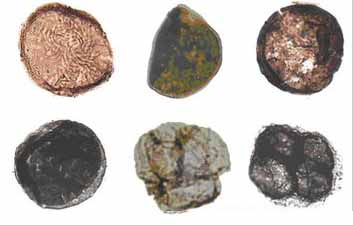
One of the categories I enjoy most within Crystalinks is Paleontology. The original index, started in 1995, had 15 Paleontology files which never stopped growing as if an unfolding story - discoveries made that predate recorded history - which for some researches hope will tell the destiny of humanity on this little rock in the sky we call planet Earth. True, my interests go more to creation and ancient astronauts seeding the human race - the word "Seeds" (DNA) always the key to life.
Seeds also take us to Botany another evolutionary process on the planet, as we never stop evolving. It is thought that life has experienced here in cycles and may now be at the end of another cycle/age based on current Earth changes. The tectonic plates are collapsing, the planet is heating up, and the sun is waking up. To this end the Svalbard Global Seed Vault was created.
Tuesday I found another interesting article to add to my Paleontology files, this one about plant life. How far back do plants go? ... further and further it would seem.
Fossils of earliest land plants discovered in Argentina BBC - October 12, 2010
- The discovery puts back by 10 million years the colonization of land by plants, and suggests that a diversity of land plants had evolved by 472 million years ago. The newly found plants are liverworts, very simple plants that lack stems or roots. That confirms liverworts are likely to be the ancestors of all land plants. The appearance of plants that live on land is among the most important evolutionary breakthroughs in Earth's history. Land plants changed climates around the globe, altered soils and allowed all other multi-cellular life to evolve and invade almost all of the continental land masses.
The discovery of the oldest known land plants was made by a team of researchers led by Claudia Rubinstein of the Department of Palaeontology at the Argentine Institute of Snow, Ice and Environmental Research in Mendoza, Argentina. She and her collected samples of sediment from the Rio Capillas, in the Sierras Subandinas in the Central Andean Basin of northwest Argentina. They then processed the sediment samples by dissolving them in strong acids, taking great care to avoid contamination.
They discovered five varieties of plants. The researchers' best estimate is that the colonization of land could have occurred during the early Ordovician period (488 to 472 million years ago) or even during the late Cambrian period (499 to 488 million years ago). The previous record holder of the earliest known land plants were small liverwort cryptospores found in Saudi Arabia and the Czech Republic. These were dated at 463 to 461 million years old.
All land plants produce spores or pollen in vast numbers. These spores are enclosed in a thick protective wall that is incredibly resistant, meaning they fossilize well. Whole plants fossilize less easily, explaining why the earliest "megafossils" of whole plants are much younger. Cryptospores are just like modern plant spores, except for an unusual structural arrangement. The discovery of spores from the oldest liverworts came as shock to the researchers.
The cryptospores from Argentina hint at where land plants originated. It most probably happened on Gondwana, as already demonstrated by previous discoveries, but very far, at least 5000km, from the Saudi Arabian and the Czech Republic, where previous earliest traces of land plants were found. As land plants matured, they evolved from liverworts into mosses, and then into plants known as hornworts and lycopods. Then ferns appeared before seed plants, of which there are many species today, finally evolved.